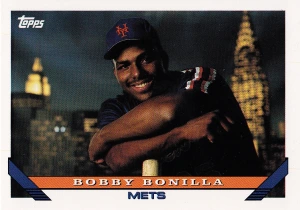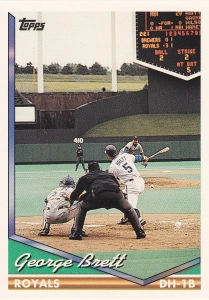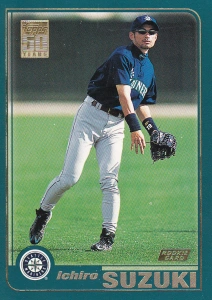On Thursday I did a post looking at 5 baseball players from the 1888 set and some guys from the current set who had an interesting comparison. Here’s the last 3 baseball players from the original set – all of whom are Hall of Famers. Interestingly, all 3 of these guys were in both the 1888 & 2011 set, but not in the 2011 set.
King Kelly

 King Kelly was the first baseball player (he’s card #1 in the 2011 set). I’ve covered him before in some of my Gypsy Queen set reviews. Kelly was still one of the better players in the game, but his very best years were already behind him by the 1888 season. He was still one of the most popular players in the game, but had already been sold by Albert Spalding to the Boston Braves in an effort to purge the Chicago ball club of all the drinkers on the team. Known for his chicanery on the diamond and his “lack of discipline” off it, he also is the subject of what is known as the first pop song, “Slide Kelly Slide”. Kelly would have 2 more good years in the National League. In Boston, he did pick up a second career as an actor, but his career and life began going downhill. He died of pneumonia in 1894 one year after being relegated to the Minor Leagues. Kelly was elected to the Hall of Fame in 1945.
King Kelly was the first baseball player (he’s card #1 in the 2011 set). I’ve covered him before in some of my Gypsy Queen set reviews. Kelly was still one of the better players in the game, but his very best years were already behind him by the 1888 season. He was still one of the most popular players in the game, but had already been sold by Albert Spalding to the Boston Braves in an effort to purge the Chicago ball club of all the drinkers on the team. Known for his chicanery on the diamond and his “lack of discipline” off it, he also is the subject of what is known as the first pop song, “Slide Kelly Slide”. Kelly would have 2 more good years in the National League. In Boston, he did pick up a second career as an actor, but his career and life began going downhill. He died of pneumonia in 1894 one year after being relegated to the Minor Leagues. Kelly was elected to the Hall of Fame in 1945.
I like the Joe Jackson card from this year’s set – and while Kelly was essentially kicked off of a couple of teams, Shoeless Joe was kicked out of the game for life. As was another guy who you can find further down in this post…
Dan Brouthers

 These three baseball players represented 75% of the 4 best players in the game in the 1880’s. Next up was another Hall of Fame player, Dan Brouthers. I also featured Brouthers in a Gypsy Queen review I did – he or Roger Connor were really the best argument for top player at the time this set came out. In 1888, Brouthers played for the defending champion Detroit Wolverines, who had bested St. Louis, the class of the American Association. Unfortunately, it would be St. Louis that lasted, as they would later move to the National League. Meanwhile, the Detroit club did not fare as well in 1888 and disbanded for financial reasons. Brouthers actually joined Kelly in Boston in 1889 and solidified his status as the game’s best a year later; like Kelly, he was also elected to the Baseball Hall of Fame in 1945.
These three baseball players represented 75% of the 4 best players in the game in the 1880’s. Next up was another Hall of Fame player, Dan Brouthers. I also featured Brouthers in a Gypsy Queen review I did – he or Roger Connor were really the best argument for top player at the time this set came out. In 1888, Brouthers played for the defending champion Detroit Wolverines, who had bested St. Louis, the class of the American Association. Unfortunately, it would be St. Louis that lasted, as they would later move to the National League. Meanwhile, the Detroit club did not fare as well in 1888 and disbanded for financial reasons. Brouthers actually joined Kelly in Boston in 1889 and solidified his status as the game’s best a year later; like Kelly, he was also elected to the Baseball Hall of Fame in 1945.
At the time the original Goodwin set came out, Dan Brouthers was the career home run leader in MLB history – with 65 at the end of the 1887 season and 74 when the 1888 season concluded. The single-season record holder is not in the original set – but Ned Williamson of Chicago, who had hit a whopping 27 home runs in the 1884 season. This was due to the tiny dimensions of Chicago’s Lake Shore Park – which was less than 200 feet down the lines. The park was the White Stockings’ home park from 1878 until they moved to West Side Park (the area where they would their home games until the team moved to Wrigley Field in 1916). But in every season through 1883, hitting the ball over the fence was counted as a double. In 1884, Chicago manager Cap Anson (see below) changed the ground rules to count these balls as home runs. Four players hit over 20 homers that year, smashing the previous record of 14. Williamson, who had set the doubles record of 49 the year before when the old rules were in place, never reached double digits in any other season.
Cap Anson

 Finally, the last of the three baseball players is probably the most famous. The previously mentioned Cap Anson certainly had the longest career of any player in the 19th century; counting his tenure in the National Association, he played for 27 seasons, from 1871 to 1897. Even in his final season, at the age of 45, he played in 114 games and hit .285. This was only his third season out of those 27 where he hit under .300. He was the first member of the 3,000 hit club, and depending on whether or not you count the National Association statistics, Anson retired with around 2,000 RBI (give or take) and around 1,900 runs scored (give or take). He was a player-manager for Chicago for 20 of those 27 seasons, winning over 1200 games and 5 NL pennants – the Colts (now the Cubs) were baseball’s first dynasty. Anson truly was baseball’s first immortal.
Finally, the last of the three baseball players is probably the most famous. The previously mentioned Cap Anson certainly had the longest career of any player in the 19th century; counting his tenure in the National Association, he played for 27 seasons, from 1871 to 1897. Even in his final season, at the age of 45, he played in 114 games and hit .285. This was only his third season out of those 27 where he hit under .300. He was the first member of the 3,000 hit club, and depending on whether or not you count the National Association statistics, Anson retired with around 2,000 RBI (give or take) and around 1,900 runs scored (give or take). He was a player-manager for Chicago for 20 of those 27 seasons, winning over 1200 games and 5 NL pennants – the Colts (now the Cubs) were baseball’s first dynasty. Anson truly was baseball’s first immortal.
That said, he had one of the biggest impacts of any figure in keeping baseball segregated; he famously refused to take the field against Moses “Fleetwood” Walker on multiple occasions. Walker was the last African-American to play in a major league until Jackie Robinson did so in 1947. 8 years before that, Anson was elected to Baseball’s Hall of Fame.
 I wanted to include two players for this one. In the history of Major League Baseball, there have been a total of 5 players who have held the career record for hits. Three of them are accounted for here.
I wanted to include two players for this one. In the history of Major League Baseball, there have been a total of 5 players who have held the career record for hits. Three of them are accounted for here.
1871: Cal McVey 66.
1872-77: Ross Barnes – up to 694.
1878-79: McVey – up to 869.
1880-1922: Cap Anson – up to 3,435.
1923-1984: Ty Cobb – up to 4,191.
1985-now: Pete Rose – up to 4,256.
Cap Anson was the first player to reach the milestones of 1, 2, and 3 thousand hits.
Ross Barnes was the best player in the National Association, which was the precursor to the National League. And for Chicago in 1876, he was the clear best player in the NL when it was founded, when he hit .429. If you list the chronological progression of all-time career leaders, the first name for most statistics usually starts with Ross Barnes. After becoming ill in 1877, he was never the same, but I believe he should be a member of the Hall of Fame for his early contributions.
Pete Rose has the worst-looking card in the entire Goodwin 2012 set.




































































